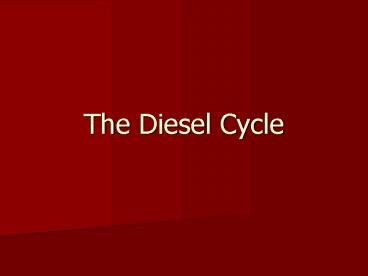The Diesel Cycle PowerPoint PPT Presentation
1 / 17
Title: The Diesel Cycle
1
The Diesel Cycle
2
The Diesel Cycle
- Rudolf Diesel developed the idea for the diesel
engine and obtained the German patent for it in
1892. His goal was to create an engine with high
efficiency. Gasoline engines had been invented in
1876 and, especially at that time, were not very
efficient.
3
- The main differences between the gas engine and
the diesel engine are - A gasoline engine intakes a mixture of gas and
air, compresses it and ignites the mixture with a
spark. A diesel engine takes in just air,
compresses it and then injects fuel into the
compressed air. The heat of the compressed air
lights the fuel spontaneously.
4
- A gasoline engine compresses at a ratio of 81 to
121, while a diesel engine compresses at a ratio
of 141 to as high as 251. The higher
compression ratio of the diesel engine leads to
better efficiency.
5
- Gasoline engines generally use either
carburetion, in which the air and fuel is mixed
long before the air enters the cylinder, or port
fuel injection, in which the fuel is injected
just prior to the intake stroke (outside the
cylinder). Diesel engines use direct fuel
injection -- the diesel fuel is injected directly
into the cylinder.
6
Illustration
- http//auto.howstuffworks.com/diesel1.htm
7
- Note the diesel engine has no spark plug, that
it intakes air and compresses it, and that it
then injects the fuel directly into the
combustion chamber (direct injection). It is the
heat of the compressed air that lights the fuel
in a diesel engine.
8
Fuel Injector
- The injector on a diesel engine is its most
complex component and has been the subject of a
great deal of experimentation -- in any
particular engine it may be located in a variety
of places. - The injector has to be able to withstand the
temperature and pressure inside the cylinder and
still deliver the fuel in a fine mist.
9
- Getting the mist circulated in the cylinder so
that it is evenly distributed is also a problem,
so some diesel engines employ special induction
valves, pre-combustion chambers or other devices
to swirl the air in the combustion chamber or
otherwise improve the ignition and combustion
process.
10
Fuel Timing
- One big difference between a diesel engine and a
gas engine is in the injection process. - Most gas engines use port injection or a
carburetor rather than direct injection. In a car
engine, therefore, all of the fuel is loaded into
the cylinder during the intake stroke and then
compressed.
11
- The compression of the fuel/air mixture limits
the compression ratio of the engine -- if it
compresses the air too much, the fuel/air mixture
spontaneously ignites and causes knocking. - A diesel compresses only air, so the compression
ratio can be much higher. - The higher the compression ratio, the more power
is generated.
12
- Some diesel engines contain a glow plug of some
sort (not shown in this figure). When a diesel
engine is cold, the compression process may not
raise the air to a high enough temperature to
ignite the fuel. - The glow plug is an electrically heated wire
(think of the hot wires you see in a toaster)
that helps ignite the fuel when the engine is
cold so that the engine can start.
13
- All functions in a modern engine are controlled
by the ECM communicating with an elaborate set of
sensors. - Glow plugs are rarely used today on larger
engines. - The ECM senses ambient air temperature and
retards the timing of the engine in cold weather
so the injector sprays the fuel at a later time. - The air in the cylinder is compressed more,
creating more heat, which aids in starting.
14
- Smaller engines and engines that do not have such
advanced computer control use glow plugs to solve
the cold-starting problem.
15
Diesel Fuel
- If you have ever compared diesel fuel and
gasoline, you know that they are different. - They certainly smell different.
- Diesel fuel is heavier and oilier.
- Diesel fuel evaporates much more slowly than
gasoline -- its boiling point is actually higher
than the boiling point of water. - You will often hear diesel fuel referred to as
"diesel oil" because it is so oily.
16
- Diesel fuel evaporates more slowly because it is
heavier. - It contains more carbon atoms in longer chains
than gasoline does (gasoline is typically C9H20,
while diesel fuel is typically C14H30). - It takes less refining to create diesel fuel,
which is why it is generally cheaper than
gasoline.
17
- Diesel fuel has a higher energy density than
gasoline. On average, 1 gallon (3.8 L) of diesel
fuel contains approximately 155x106 joules
(147,000 BTU), while 1 gallon of gasoline
contains 132x106 joules (125,000 BTU). - This, combined with the improved efficiency of
diesel engines, explains why diesel engines get
better mileage than equivalent gasoline engines.

